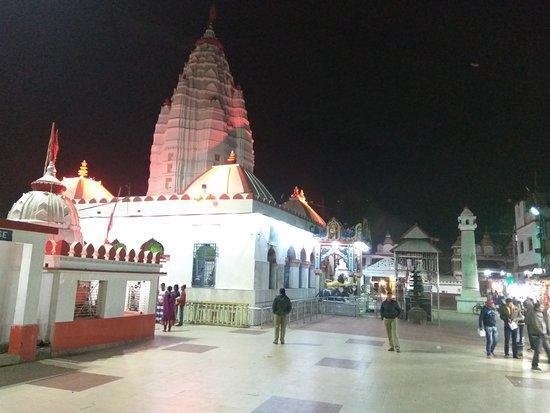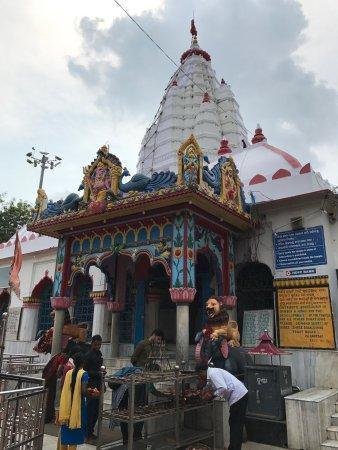Samaleswari Temple, Sambalpur, Odisha
| Date built: | – |
|---|---|
| Deity: | – |
| Architectural style: | Kalinga Architecture, Hindu Temple Architecture, Stone and Limestone |
| Major festivals | Nuakhai, Navaratra Puja |
| Locale: | Sambalpur |
| District:: | Sambalpur |
| Address: | Ray Pada, Khetrajpur, Sambalpur, Odisha 768003 |
| Phone | 06632401369 |
Shree Shree Samaleswari, the presiding deity of Sambalpur, is a strong religious force in the western part of Orissa and Chhattisgarh state of India. On the bank of the river Mahanadi the mother goddess Samaleswari is worshipped from ancient times as Jagatjanani, Adishakti, Mahalaxmi and Mahasaraswati. The region in which the temple is situated has a rich cultural heritage. Sambalpur region is popularly known as Hirakhanda from ancient times. Ptolemy has described the place as Sambalak, According to Tavernir, the French traveller, and Edward Gibbon, the English historian, diamonds were exported to Rome from Sambalpur
Sambalpur is located in the eastern county of India at a distance of 320 k.m. from the capital of Odisha, Bhubaneswar. The Samaleswari Temple is situated in the central area of the city Sambalpur, Whereas it used to be known for its importance as a diamond trading centre, nowadays it is mainly known for its textiles. It’s a good place from which to explore the surrounding forests and spot some of the rare species still roaming the area in one of the wildlife sanctuaries, such as the well-known Badrama sanctuary.
Although Sambalpur does take a prominent place in Indian history, it does not have that many historical sights. The most important temples in the district, such as the Budha Raja or the Samaleswari temple, are located at a few kilometres’ distances from Sambalpur. The Hirakud Dam, the longest dam in the world, is some 15 kilometres from Sambalpur and can be easily visited on a day trip.
Sambalpur is famous for Sambalpuri songs, dances, forest and world-famous Sambalpuri handloom fabrics. The rhythmic beats of Sambalpuri drums are heart-pounding and pulse racing and create profound joy.
Maa Samaleswari temple is positioned on the reservoir of the river Mahanadi, Sambalpur district, Orissa। It is a famous Shakti Peetha. It is very well-known among the people of Orissa and Chhatisgarh state. Maa Samaleswari is worshipped as a form (deity) of Goddess Durga. The Goddess is famously known as ‘Shree Shree Samalai Devi’ or ‘Maa Samalai’. The icon of Maa Samalai is made out of granite rock. A few decades before, animal (buffalo) sacrifices were done in the temple, which has been stopped now. Local people have a strong belief in ‘Maa Samaleswari’. See other Temples in Odisha.
Architecture
Legend / Local stories
Samaleswari Temple is a Hindu temple in Sambalpur, Western Odisha, India dedicated to the goddess known as ‘Maa’, also known among the natives as samalei maa, meaning Mother[Samaleswari]]. Shree Shree Samaleswari, the presiding deity of Sambalpur, is a strong religious force in western part of Odisha and Chhattisgarh state of India. On the bank of the river Mahanadi the mother goddess Samaleswari is worshipped from ancient times as Jagatjanani, Adishakti, Mahalaxmi and Mahasaraswati. The region in which the temple is situated has a rich cultural heritage. Sambalpur region is popularly known as Hirakhanda from ancient times. Ptolemy has described the place as Sambalak, according to Tavernir, the French traveller, and Edward Gibbon, the English historian, diamonds were exported to Rome from Sambalpur.
The temple is of Sandhara order( These types of the temples have a square sanctum enclosed by a gallery of pillars meant for Pradakshina). Thus, the Sandhara temples have a Pradakshinapatha is built of a kind of stone durable as granite, cemented with lime mortar, the whole building is plastered, but in the course of time the surface has become mouldy. The temple comprises two separate structures. The square sanctum sanctorum enshrining the deity is four step below the 10-foot-wide (3.0 m) covered circumambulation, which is supported by 12 stone pillars. Eleven parswa devis (side Goddess), are embedded on the outer wall of the sanctum, so that the devotees can worship those deities during parikarma through the vaulted circumambulation. The Idol of Shree Shree Samalai Devi consists of a large block of Granite rock with an inverted, trunk like projection at the bottom. A shallow cut on her “Baraha” like face symbolises her mouth. Traditional Sambalpuri nose ornament of pure gold hangs down from her imaginary nose Beaten gold leave fixed on two disproportionate golden eye like depression on the face acts as substitute for her eyes in an attempt to define the face of the mother deity on a mass of self shaped rock, the devi’s idol inspires sublime sentiments of awe, fear, reverence, devotion, love and affection towards all-pervading motherhood.
She is worshiped with a great care and devotion by the natives in her temple, famously known as the samaleswari temple. Among the varieties of festivals observed before the goddess throughout the year three festivals are observed prominently. The first two are navaratra puja during the months of March and April and during the months of September and October. Among these two navaratra pujas (nine days continuous worship of the goddess) the second one is observed with a great splendour and devotion. The third festival which is said to be the chief festival of the whole western Orissa (sambalpur ) region is nuakhai. In this festival the farmers offer the first produce from their lands to the goddess before using it for his personal use.
Photo Gallery
How to Reach:
There are direct trains to Sambalpur from Delhi, Kolkata, Bombay, Chennai, and Ahmadabad. Buses from main cities also run to Sambalpur in National Highway. The nearest airport is in Raipur (270 km). From Bhubaneswar airport the distance is 320 km. There are hotels and guest houses available near the temple for accommodation.
Contact Details
Official Address






















